The global cyprosin market is projected to grow steadily at a CAGR of 3.7%, reaching an estimated value of USD 898.7 million in 2025 and crossing USD 1,292.4 million by 2035. This growth reflects increasing adoption of the product in industrial and food applications, especially within the dairy sector.
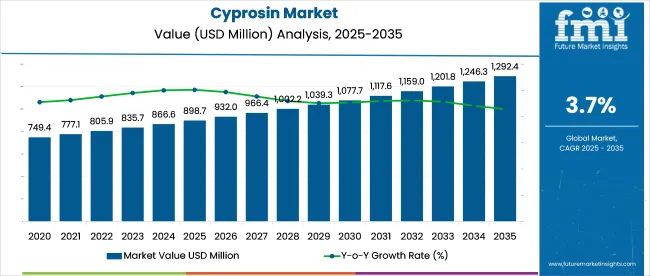
Cyprosin, an aspartic protease enzyme primarily derived from plant and microbial sources, is widely recognized for its milk coagulating properties, making it an essential rennet substitute in cheese manufacturing. Technological developments in enzyme production and fermentation methods have enhanced product efficiency, purity, and shelf stability, which in turn has widened their use in specialized functional foods, nutraceuticals, and even certain pharmaceutical formulations.
The industry represents a niche but growing segment within several broader ingredient and enzyme categories. Within the USD 12-14 billion global enzymes market, cyprosin accounts for 0.5-0.8%, reflecting its specialized dairy application. In the USD 3.5 billion food enzymes market, its share rises to 1.2-1.6%, driven by demand in cheese manufacturing.
The dairy processing aids market, valued at around USD 2.5 billion, sees product capturing 2-3%, largely due to its role as a rennet alternative. Within the USD 100 billion functional food ingredients market, the product holds a modest 0.1-0.2% share, primarily due to its niche uses. In the biotech-based ingredients market (USD 40 billion), its share is estimated at 0.2-0.4%, reflecting low volume but high specialization in fermentation-derived enzyme solutions.
The market involves a multi-stage process beginning with raw material sourcing, particularly the extraction of enzymes from cardoon (Cynara cardunculus), fig latex, or through microbial fermentation. Upstream players typically include plant growers or microbial culture developers, enzyme formulators, and biotech firms responsible for extraction, isolation, and stabilization.
Midstream involves bulk production, standardization, quality assurance, and packaging, often led by specialized enzyme manufacturers or contract processing facilities. Downstream stakeholders include dairy processors, food manufacturers, pharmaceutical firms, and distributors, who integrate cyprosin into end-use applications.
With supply chains increasingly emphasizing traceability and scalability, companies are investing in cleaner extraction technologies, cold-chain logistics, and regional sourcing strategies to minimize risk and maximize value creation across the value chain.
The cyprosin market is led by the natural source, powdered form, and cheese and cheese products segments, driven by growing demand for clean-label, plant-based, and food processing aids. Natural cyprosin dominates due to its non-GMO profile, while powdered variants offer superior shelf life and processing efficiency. Cheese applications account for over 70% of market use, with other segments remaining niche.
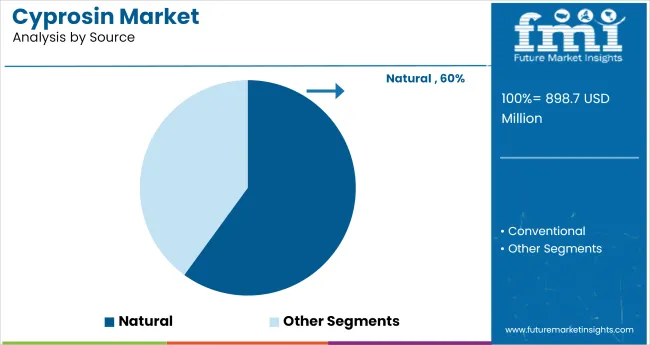
The natural segment holds the leading share in the market by source, accounting for over 60% of the total market revenue in 2025. This dominance is attributed to rising consumer preference for clean-label, plant-based, and enzyme-derived ingredients that align with vegetarian food processing trends.

In the market, the powder form leads in terms of market share, contributing nearly 65% of the total revenue in 2025.
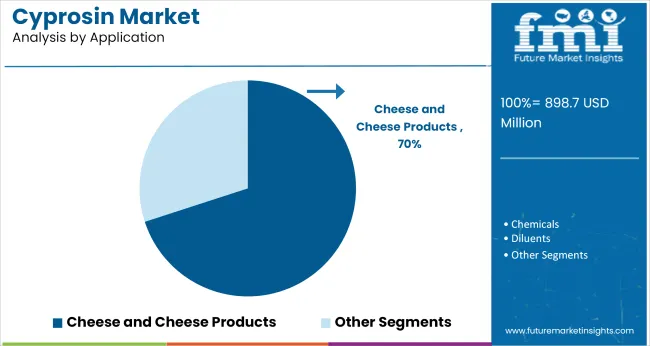
Cheese and cheese products represent the leading application segment in the market, accounting for over 70% of the total market share in 2025.
Rising regulatory scrutiny and evolving consumer preferences are accelerating the shift toward natural, label-compliant products in cheese production. Manufacturers are prioritizing plant-based and traceable enzyme sources to meet clean-label and vegetarian demand across major regions.
Regulatory Pressures Boost Demand for Natural and Label-Compliant Cyprosin
The industry is increasingly influenced by stringent food labeling regulations and ingredient traceability requirements. As plant-based and microbial enzyme sources gain regulatory approval across key markets like the EU, manufacturers are accelerating the shift away from animal-derived rennet. In 2025, over 68% of products used in cheese production in Europe met “vegetarian” or “non-animal origin” labeling requirements, up from 52% in 2022.
In Latin America, food processors reported a 23% increase in plant-extracted product usage following alignment with clean-label certification norms. As regulatory audits become more frequent, producers with full-source traceability are favored in long-term supply contracts.
Consumer Demand for Vegetarian Dairy Driving Enzyme Substitution Patterns
Shifting consumer preferences are reshaping the enzyme procurement strategies of dairy manufacturers. The growing demand for vegetarian and non-GMO cheeses, especially among millennials and Gen Z in urban centers, has driven a sharp uptick in microbial and plant-based coagulants like cyprosin.
In 2025, more than 72% of new cheese launches in North America featured “vegetarian-friendly” or “animal-free” claims. Retail scanner data shows a 16% premium pricing window for products using natural product versus animal rennet. Supermarket private labels in Western Europe are also revising their sourcing models, with 38% of new contracts in 2025 requiring non-animal enzyme inputs.
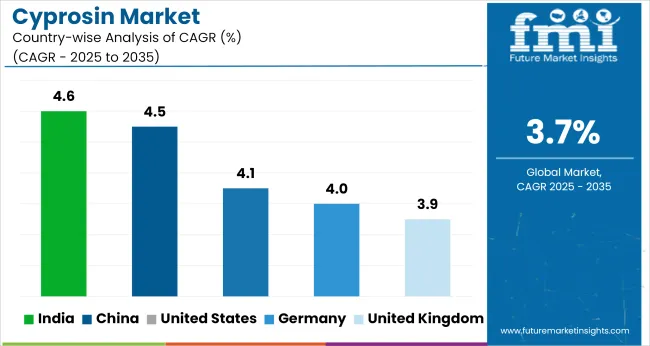
| Countries | CAGR (2025 to 2035) |
|---|---|
| United States | 4.1% |
| United Kingdom | 3.9% |
| Germany | 4.0% |
| China | 4.5% |
| India | 4.6% |
The global cyprosin market is projected to grow at a 3.7% CAGR from 2025 to 2035, with BRICS nations showing a stronger-than-average trajectory. India leads with 4.6%, supported by expanding cheese production in tier-2 processing zones and increasing reliance on non-animal rennet substitutes for vegetarian formulations.
China follows at 4.5%, driven by scale-up in dairy analogues and growing enzyme applications in high-volume industrial bakeries. Both countries are investing in microbial fermentation infrastructure to ensure stable product yields.
Among OECD economies, the United States posts 4.1%, modestly above the global average, fueled by demand from clean-label cheese brands and co-manufacturers reformulating with microbial rennet. Germany records 4.0%, benefiting from export-oriented specialty cheese production.
The United Kingdom lags slightly at 3.9%, with slower penetration due to cost-sensitivity in processed cheese categories. ASEAN countries, though not in the top tier, are witnessing early-stage demand as artisanal and plant-based cheese segments gain traction, especially in Thailand and Vietnam.
The report covers a detailed analysis of 40+ countries, and the top five countries have been shared as a reference.
The UK cyprosin market registered a CAGR of 2.4% between 2020 and 2024, primarily influenced by conservative adoption among traditional dairy manufacturers and limited penetration of natural coagulants in industrial-scale production. However, this dynamic has shifted notably.
From 2025 to 2035, the CAGR is projected to rise to 3.9%, outpacing the global average of 3.7%. This acceleration is driven by the UK’s strong regulatory alignment with EU labeling norms, increasing consumer demand for vegetarian cheese, and supermarket chains mandating clean-label sourcing.
In 2024, over 61% of new cheese products carried non-animal origin claims. As local producers adjust to comply with traceability and origin transparency, demand for plant-based products is climbing. Growth in artisanal and organic cheese production in regions like Somerset and Yorkshire supports long-term enzyme substitution trends.
The USA cyprosin market grew at a CAGR of 2.9% between 2022 and 2024, held back by slow industry transition from animal rennet and limited regulatory pressure on enzyme origin. However, a surge in flexitarian and clean-label consumer preferences is expected to lift the CAGR to 4.1% between 2025 and 2035.
The USA leads global cheese production, and with over 72% of new cheese product launches carrying “vegetarian” or “non-animal” labels in 2025, cyprosin’s role has gained prominence. The entry of private-label brands into natural cheese lines and expanded demand from plant-based protein producers further support this trend.
Cyprosin adoption is especially robust in California and Wisconsin, where clean-label cheese is strong. Industrial players are also replacing animal enzymes to meet export market requirements.
Germany’s cyprosin market posted a CAGR of 2.7% between 2020 and 2024, shaped by early but cautious adoption in the organic and specialty dairy segments. Looking forward, the market is expected to grow at a stronger CAGR of 4.0% from 2025 to 2035, supported by regulatory reinforcement of non-animal origin requirements and the country’s robust organic certification ecosystem.
Germany is among the largest cheese producers in the EU and is at the forefront of plant-based food transitions. In 2025, nearly 65% of premium cheese products sold in urban centers like Berlin and Munich were labeled rennet-free. Producers are also targeting export-oriented clean-label products to other EU markets. High consumer trust in biotech-based food processing and extensive private-label investments are accelerating enzyme substitution, boosting natural cyprosin demand.
In China, the cyprosin market grew at a CAGR of 3.3% between 2020 and 2024, driven by increased cheese consumption in urban centers but limited by low awareness of enzyme sourcing. However, with evolving consumer awareness and rapid Westernization of diets, the CAGR is projected to rise to 4.5% from 2025 to 2035.
The expansion of Western-style dairy products and domestic brands investing in organic and clean-label offerings has created a favorable environment for natural products. Government-backed food modernization programs and investment in bioprocessing technologies are also reducing reliance on imports.
Tier-1 cities like Shanghai and Beijing are seeing strong demand for natural coagulants, with the foodservice sector embracing enzyme transparency. Cheese featuring plant enzymes has grown 3× since 2023, supported by premium health-positioned brands.
India’s cyprosin market grew at a CAGR of 3.1% between 2020 and 2024, largely driven by imports serving high-end artisanal cheese brands in metro cities. From 2025 to 2035, the CAGR is forecast to climb to 4.6%, the highest among the five countries analyzed.
This growth is powered by expanding dairy hubs in Gujarat and Maharashtra, where vegetarian cheese products are increasingly using plant-based coagulants. As Ayurveda-aligned and religious dietary preferences reject animal rennet, demand for the product, especially fig- and cardoon-derived variants, is growing rapidly.
Domestic enzyme formulation capabilities are improving, reducing costs and supply risks. Indian dairy cooperatives are also scaling up plant-based cheese for export to Europe and the Middle East, boosting industrial-scale enzyme adoption.
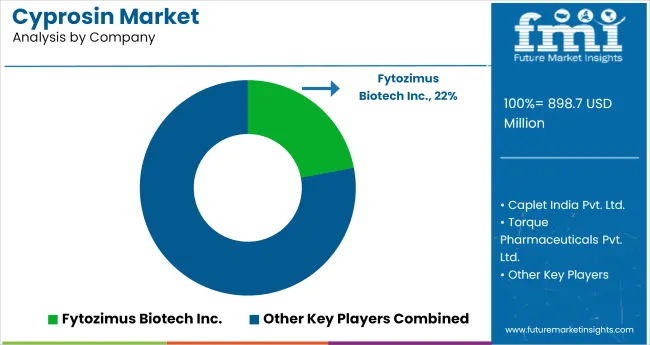
Fytozimus Biotech Inc. is emerging as a leading player in the cyprosin market, known for its focus on plant-derived enzyme formulations tailored for clean-label dairy applications. The company leverages advanced fermentation technology and strategic partnerships with cheese manufacturers in Europe and Asia to expand its footprint. Its emphasis on traceable, non-animal coagulants has positioned it favorably among regulatory-conscious buyers.
The competitive landscape is moderately fragmented, with companies like Caplet India Pvt. Ltd., Intas Pharmaceuticals Ltd., and Torque Pharmaceuticals competing on cost-efficiency and regional distribution. Players such as Geno Pharmaceuticals and Zenon Healthcare are strengthening their presence through contract manufacturing and enzyme R&D. Strategic alliances, compliance-driven, and expanded plant-based portfolios remain key growth levers across this evolving market.
Recent Cyprosin Industry News
| Report Attributes | Details |
|---|---|
| Market Size (2025) | USD 898.7 million |
| Projected Market Size (2035) | USD 1,292.4 million |
| CAGR (2025 to 2035) | 3.7% |
| Base Year for Estimation | 2024 |
| Historical Period | 2020 to 2024 |
| Projections Period | 2025 to 2035 |
| Quantitative Units | USD million for value and volume in metric tons |
| Source Analyzed (Segment 1) | Conventional and Natural. |
| Form Analyzed (Segment 2) | Liquid and Powder. |
| Applications Analyzed (Segment 3) | Cheese And Cheese Products, Chemicals, Diluents, Pharmaceuticals, Preservatives, Stabilisers, and Other. |
| Regions Covered | North America, Europe, Asia Pacific, Middle East & Africa, Latin America |
| Countries Covered | United States, Canada, Germany, United Kingdom, France, Italy, Spain, China, Japan, South Korea, India, Australia, Brazil, Mexico, Argentina, Saudi Arabia, UAE, South Africa |
| Key Players | Fytozimus Biotech Inc., Caplet India Pvt. Ltd., Torque Pharmaceuticals Pvt. Ltd., Jupiter Pharmaceuticals Limited, Zenon Healthcare Limited, Geno Pharmaceuticals Ltd., Intas Pharmaceuticals Ltd., Radico Remedies. |
| Additional Attributes | Dollar sales, share, demand by source and form, key application areas, regional growth hotspots, regulatory shifts, pricing trends, competitor positioning, and clean-label adoption rates. |
The industry is segmented into conventional and natural.
The industry is segmented into liquid and powder.
The industry finds applications in cheese and cheese products, chemicals, diluents, pharmaceuticals, preservatives, stabilisers, and other products.
The industry covers regions including North America, Europe, Asia Pacific, Latin America, and the Middle East & Africa.
The global cyprosin market is estimated to be valued at USD 896.1 million in 2025.
The market size for the cyprosin market is projected to reach USD 1,288.7 million by 2035.
The cyprosin market is expected to grow at a 3.7% CAGR between 2025 and 2035.
The key product types in cyprosin market are conventional and natural.
In terms of form, liquid segment to command 60.0% share in the cyprosin market in 2025.






Our Research Products

The "Full Research Suite" delivers actionable market intel, deep dives on markets or technologies, so clients act faster, cut risk, and unlock growth.

The Leaderboard benchmarks and ranks top vendors, classifying them as Established Leaders, Leading Challengers, or Disruptors & Challengers.

Locates where complements amplify value and substitutes erode it, forecasting net impact by horizon

We deliver granular, decision-grade intel: market sizing, 5-year forecasts, pricing, adoption, usage, revenue, and operational KPIs—plus competitor tracking, regulation, and value chains—across 60 countries broadly.

Spot the shifts before they hit your P&L. We track inflection points, adoption curves, pricing moves, and ecosystem plays to show where demand is heading, why it is changing, and what to do next across high-growth markets and disruptive tech

Real-time reads of user behavior. We track shifting priorities, perceptions of today’s and next-gen services, and provider experience, then pace how fast tech moves from trial to adoption, blending buyer, consumer, and channel inputs with social signals (#WhySwitch, #UX).

Partner with our analyst team to build a custom report designed around your business priorities. From analysing market trends to assessing competitors or crafting bespoke datasets, we tailor insights to your needs.
Supplier Intelligence
Discovery & Profiling
Capacity & Footprint
Performance & Risk
Compliance & Governance
Commercial Readiness
Who Supplies Whom
Scorecards & Shortlists
Playbooks & Docs
Category Intelligence
Definition & Scope
Demand & Use Cases
Cost Drivers
Market Structure
Supply Chain Map
Trade & Policy
Operating Norms
Deliverables
Buyer Intelligence
Account Basics
Spend & Scope
Procurement Model
Vendor Requirements
Terms & Policies
Entry Strategy
Pain Points & Triggers
Outputs
Pricing Analysis
Benchmarks
Trends
Should-Cost
Indexation
Landed Cost
Commercial Terms
Deliverables
Brand Analysis
Positioning & Value Prop
Share & Presence
Customer Evidence
Go-to-Market
Digital & Reputation
Compliance & Trust
KPIs & Gaps
Outputs
Full Research Suite comprises of:
Market outlook & trends analysis
Interviews & case studies
Strategic recommendations
Vendor profiles & capabilities analysis
5-year forecasts
8 regions and 60+ country-level data splits
Market segment data splits
12 months of continuous data updates
DELIVERED AS:
PDF EXCEL ONLINE

Thank you!
You will receive an email from our Business Development Manager. Please be sure to check your SPAM/JUNK folder too.
Chat With
MaRIA